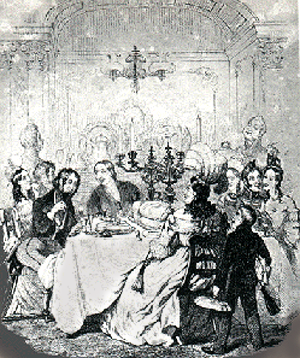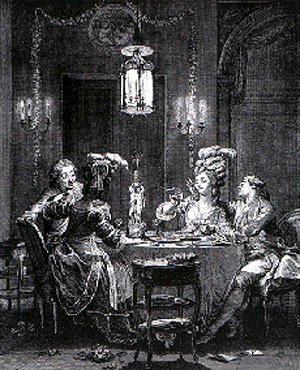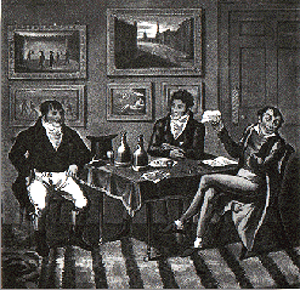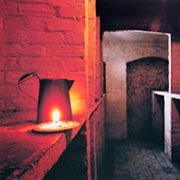Mealtimes
You can try historic food for yourself in this historic chocolate tart recipe something which would probably have been eaten in the Town House when it was first occupied.
Find out more about Regency Food by visiting the Town House's own Regency Cook, Paul Couchman here
Breakfast
Before the start of the Regency period, breakfast had been a large, hearty meal consisting of eggs, kidneys, chops and liver, and eaten at about 10.00 am.
Many professionals started the day at about 7.00am or 8.00am and needed a large meal at this time to sustain them until dinner. However a Regency breakfast was a relaxed, informal meal, eaten in the Drawing room and would have been based around cakes.
Favourites included honey cake, plum cake, French bread and brioche. Popular spices used in morning cakes were caraway seeds, saffron and ground ginger. Tea and hot chocolate were favoured as morning drinks, although the Prince Regent and many of the Dandy set were known to drink alcohol first thing.

Right: 'A Brighton Breakfast', or 'Morning Comforts' by Charles Williams, published Oct 1802. It depicts Mrs Fitzherbert and Lady Lade.
Lunch
Lunch was quite a new 'invention'. As breakfast was being eaten earlier and dinner being eaten later, it introduced the need to snack, to fill the gap.
This snacking became 'lunch' and was eaten between 1.00pm and 3.00pm. It was around this time that sandwiches were first seen, although not as we know them today - in the Regency period they were very small triangles eaten using a knife and fork. As well as these cold meats, more cakes and fruits were often served.

Dinner
Dinner was normally eaten at about 5.00pm, but this really depended on where you lived and your social status. It was one of the most showy and extravagant meals, particularly if their were guests. Guests would be seated around a large table in the dining room, one of the most lavishly decorated rooms in the house.
All the dishes for all the courses were laid on the table at the start of the meal and etiquette noted that the table should be 'covered but not crowded'. The first course would probably be soup, common flavours being chestnut or artichoke.
In seaside towns such as Brunswick town, there would almost certainly be a fish course, as it was easy to get fresh fish. A common dish was Mackerel with fennel and mint.
Next would come the second course, roasted meat would be served, sweet and savoury pies and tarts would be started, and also the game and fish courses. Vegetables were also brought out at this point, they would often be drowned in a rich butter sauce, as butter was more expensive than meat it showed off the wealth of the host.
Pickled vegetables were also very popular. (vegetables were quite new in fashion as before Regency times, it was a common belief that vegetables were bad for you!) Desert was then dished up. Often these were displayed in a fashionable pyramid shape, especially fruits and marzipan.

Sugar was believed to help digestion and often a drink containing a spiced, sweet ginger was also consumed to help 'close an overfull stomach'. Comforts were also eaten. These were roots and spices covered in layers of sugar, also believed to be medicinal, liquorice still remains popular today.
Supper
This meal was eaten as late as 10.00 or 11.00 at night. Returning from the opera or theatre in a coach, people would need a warming drink or light meal such as soup. Often a 'negus' was made up for guests twenty minutes before they were due to leave. It was made of calves foot jelly, wine, boiling water, lemon and spices.

Right: Three gentlemen having a glass of Claret. This is a detail from a Cruikshank engraving.
Try making this incredible chocolate tart recipe for yourself it is something which might have graced the Town House's dining room table when the house was first occupied.
To find out more about Regency Food visit the Town House's own Regency Cook, Paul Couchman here



